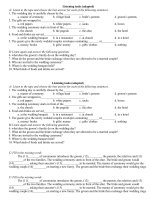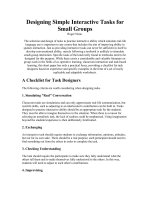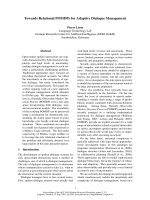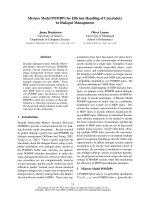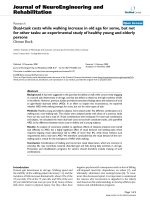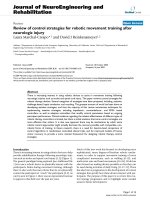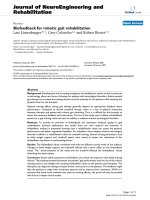Continuous POMDPs for robotic tasks
Bạn đang xem bản rút gọn của tài liệu. Xem và tải ngay bản đầy đủ của tài liệu tại đây (6.55 MB, 140 trang )
CONTINUOUS POMDPS FOR
ROBOTIC TASKS
Bai, Haoyu
B.Sc., Fudan University, 2009
A THESIS SUBMITTED
FOR THE DEGREE OF DOCTOR OF
PHILOSOPHY
SCHOOL OF COMPUTING
NATIONAL UNIVERSITY OF SINGAPORE
2014
Declaration
Iherebydeclarethatthisthesisismyoriginalworkandithasbeen
written by me in its entirety. I have duly acknowledged all the sources of
information which have been used in the thesis.
This thesis has also not been submitted for any degree in any university
previously.
Bai, Haoyu
September 23, 2014
i
Acknowledgements
I woul d like to thank my advisor, Professor David Hsu, for all of his
support and insight. Davi d is a guide, not only for the journey towards
this thesis, but also the journey toward s a meaningful life. His in si g htful
suggestions and our heated discussions always echo over my ears, and will
cont inue to reform my perspective towards the world. Professor Lee Wee
Sun has also closely advised my research. With his deep knowledge and
sharp mind, Wee Sun has generated so many sparks in our discussions.
I appreciate the suggestions by Professor Leong Tze Yun and Professor
Bryan Low, which are very helpful in improving the thesis.
Abigportionofmytimeonthistropicalislandisspentinoursmallbut
cozy lab, which is shared with many labmates: Wu Dan, Amit Jain, Koh
Li Ling, Won Kok Sung, Lim Zhan Wei, Ye Nan, Wu Kegui, Cao Nannan,
Le Trong Dao, etc I have learnt so much from them.
I am f or t u n at e to meet many good friends, including my alum n i , Luo
Hang, and my roommates, Cheng Yuan, Lu Xuesong, Wei Xuelia n g, and
Gao Junhong. Because of them, the life in Singapore is more colorful.
It is wonderful that wherever I go there are always old fr i en d s awaiting
me. Qianqian in Mun i ch, Huichao i n Pittsburgh, Jianwen and Jing in
Washington D.C., Siyu, Wenshi and Sh i in Beijing, Zhiqing in Tianjin,
Ning, Xueliang and many other friends i n the Bay Area. Faraway from
home, we are supporting each other.
I will always remember the h e ar twarming scene of my father, Bai Jian-
i
hua, using a small knife, sharpening pencils for me in the early school years.
My mother, Wang Guoli, introduced me to computer science and always
encourage me to pursue my dr ea m . I am so grateful that th ey gave me my
first PC, a 80286, which accompanied me for many joyful days and nights.
The most important wisdom I have ever heard is from my grandma: “Don’t
do evil with your technology.”
Finally, to my wife Yumei, who keep s feeding me the energy so that I
can complete this thesis.
ii
Contents
List of Tables vii
List of Figures ix
1 Introduction 1
1.1 Overview . . . . . . . . . . . . . . . . . . . . . . . . . . . . . 1
1.2 Contribution . . . . . . . . . . . . . . . . . . . . . . . . . . . 4
1.3 Outline . . . . . . . . . . . . . . . . . . . . . . . . . . . . . . 6
2 Background 9
2.1 POMDP Preliminary . . . . . . . . . . . . . . . . . . . . . . 9
2.2 Related Work . . . . . . . . . . . . . . . . . . . . . . . . . . 12
3 Continuous-state POMDPs 25
3.1 Modelling in Continuous Space . . . . . . . . . . . . . . . . 25
3.2 Value Iteration and Policy Graph . . . . . . . . . . . . . . . 28
3.3 Monte Carlo Value Iteration . . . . . . . . . . . . . . . . . . 31
3.4 Analysis . . . . . . . . . . . . . . . . . . . . . . . . . . . . . 37
3.5 Experiments . . . . . . . . . . . . . . . . . . . . . . . . . . . 42
3.6 Application to Unmanned Aircraft Collision Avoidance . . . 48
3.7 Summary . . . . . . . . . . . . . . . . . . . . . . . . . . . . 58
4 Planning How to Learn 61
i
4.1 Overview . . . . . . . . . . . . . . . . . . . . . . . . . . . . . 61
4.2 Problem Formulation . . . . . . . . . . . . . . . . . . . . . . 64
4.3 Algorithm . . . . . . . . . . . . . . . . . . . . . . . . . . . . 66
4.4 Experiments . . . . . . . . . . . . . . . . . . . . . . . . . . . 69
4.5 Summary . . . . . . . . . . . . . . . . . . . . . . . . . . . . 76
5 Continuous-observation POMDPs 79
5.1 Generalized Policy Graph . . . . . . . . . . . . . . . . . . . 79
5.2 Algorithm . . . . . . . . . . . . . . . . . . . . . . . . . . . . 81
5.3 Analysis . . . . . . . . . . . . . . . . . . . . . . . . . . . . . 85
5.4 Experiments . . . . . . . . . . . . . . . . . . . . . . . . . . . 90
5.5 Proofs . . . . . . . . . . . . . . . . . . . . . . . . . . . . . . 103
5.6 Summary . . . . . . . . . . . . . . . . . . . . . . . . . . . . 110
6 Conclusion 113
Bibliography 117
ii
Abstract
Planning under uncerta i n and dynami c environments is an essential ca-
pability for autonomous robots. Partially observable Markov decision pro-
cesses (POMDPs) prov i de a general framework for solving such problems
and have been applied to di↵erent robotic tasks such as manipulation with
robot hands, self-driving car navigation, and unmanned aircraft collision
avoidance. Whi l e there is dr am a t i c progress in solving discrete POMDPs,
progress on continuous POMDPs has been limited. However, it is often
much more natural to model robotic tasks in a continuous space.
We developed several algorithms that enable POMDP planning with
cont inuous states, continuous observations as well as continuous unknown
model parameters. These algorithms have been app l i ed to di↵erent robotic
tasks such as unmanned aircraft collision avoidance and autonomous vehicle
navigation. Experimental results for these robotic tasks demonstrated the
benefits of probabilistic planning with continuous models: continuous mod-
els are simpler to const r u ct and provide more accurate description of the
robot system; our continuous planning algorithms are general for a broad
class of tasks, scale to more difficult problems and often results in improved
performance comparing with discrete planning. Therefore, these algorith-
mic and modeling te chniques are powerful t ools for robotic planning under
uncertainty. These tools are necessary for building more intelligent and
reliable robots and would eventually lead to wider application of robotic
technology.
iii
iv
Publications fr om the Thesis
Research Work
[
1
]
Haoyu Bai, Davi d Hsu, and Wee Sun Lee. Integrated perception and
planning in the continuous space: A POMDP approach. Invited paper.
The International Journal of Robotics Research,2014.
[
2
]
Haoyu Bai, David Hsu, and Wee Sun Lee. Integrated perception
and planning in the continuous space: A POMDP approach. In Proc.
Robotics: Science and Systems,2013.
[
3
]
Haoyu Bai, David Hsu, and Wee Sun Lee. Planning how to learn. In
Proc. IEEE Int. Conf. on Robotics & Automation,2013.
[
4
]
Haoyu Bai, David Hsu, Wee S u n Lee, and Mykel Kochend er fer . Un-
manned aircraft collision avoidance using continuous-state POMDPs.
In Proc. Robotics: Science and Systems,2011.
[
5
]
Haoyu Bai, David Hsu, Wee Sun Lee, and Vien Ngo. Monte carlo
value iteration for continuous-state POMDPs. In Proc. Workshop on
the Algorithmic Foundations of Robotics,2010.
v
vi
List of Tables
3.1 Comparison of Per seu s and MCVI on the navigation task. . 42
3.2 Sensor parameters. . . . . . . . . . . . . . . . . . . . . . . . 53
3.3 Performance comparison of threat resolution logic. . . . . . 53
3.4 Risk ratio versus maneuver penalty. . . . . . . . . . . . . . . 54
4.1 Comparison of policies for acrobot swing-up. . . . . . . . . . 71
4.2 Comparison of policies for pedestrian avoidance. . . . . . . . 75
5.1 The size, execution speed and planning time of computed
policies. . . . . . . . . . . . . . . . . . . . . . . . . . . . . . 92
5.2 Performance comparison of POMDP p oli c i es with two dif-
ferent observation models for intersection navigation. . . . . 95
5.3 Performance with increasing sensor noise. . . . . . . . . . . 96
5.4 Performance comparison with MC-POMDP. . . . . . . . . . 100
5.5 The performan ce of acrob o t POMDP pol i ci es with di↵erent
values of sample parameter N 102
vii
viii
List of Figures
1.1 Pedestrian avoidance for autonomous vehicles. . . . . . . . . 3
2.1 Taxonomy of planning under uncertainty techniques. . . . . 12
2.2 Model expressiveness and solution optimality of POMDP
planning algorithms. . . . . . . . . . . . . . . . . . . . . . . 17
3.1 Corridor navigation. . . . . . . . . . . . . . . . . . . . . . . 26
3.2 A p olicy graph. . . . . . . . . . . . . . . . . . . . . . . . . . 29
3.3 Backup of a policy graph G 31
3.4 A b elief tree rooted at an initial belief b
0
. . . . . . . . . . 35
3.5 Performance of MCVI versus continuous Perseus on the nav-
igation task. . . . . . . . . . . . . . . . . . . . . . . . . . . . 43
3.6 Performance of MCVI with respect to N on the navigation
task. . . . . . . . . . . . . . . . . . . . . . . . . . . . . . . . 43
3.7 Empirical convergence rate of MCVI. . . . . . . . . . . . . . 44
3.8 Simulations runs for three ORS models. . . . . . . . . . . . . 46
3.9 Policy graph for aircraft collision avoidance. . . . . . . . . . 57
4.1 The acrob ot. . . . . . . . . . . . . . . . . . . . . . . . . . . . 62
4.2 The acrobot dynamics is sensitive to model parameters. . . . 70
4.3 Acrobot swing-up trajectories. . . . . . . . . . . . . . . . . . 72
4.4 The average belief entropy and the torque variance over time
for a POMDP policy in simulation. . . . . . . . . . . . . . . 72
ix
4.5 Pedestrian avoidance. . . . . . . . . . . . . . . . . . . . . . . 74
4.6 The average belief entropy and the average vehicle speed for
pedestrian avoidance in simulations. . . . . . . . . . . . . . 76
5.1 Intersection navigation. . . . . . . . . . . . . . . . . . . . . 80
5.2 Comparing the LQG POMDP policy and the linear feedback
policies. . . . . . . . . . . . . . . . . . . . . . . . . . . . . . 91
5.3 Posterior beliefs b
1
, b
2
,andb,fromlefttoright. . . . . . . . 94
5.4 Empirical convergence rates with respect to N 98
5.5 A histogram of classifier errors. . . . . . . . . . . . . . . . . 98
5.6 Visualization of an edge classifier 103
x
Chapter 1
Introduction
1.1 Overview
In the past decades, robotics has grown from science fiction into an
emerging technology. Than ks to the advance of compu t er s, sensors and
actuators, the capability of robots has been growing dramatically. Imper-
fect control, noisy sensors, and incomplete knowledge of the environment,
however, pose significant challenge in robotics. Accounting for these uncer-
tainties is essential for reliable and intelligent robot operations in complex
env ir on m ents.
For example, sophisticated rob ot arms are already operating on assem-
bly lines, but they require a precisely controlled environment. Vacuum
robots are running in many homes, but they are programm ed with simple
reactive control logic. How do we enable robots for more complica t ed tasks,
such as autonomous driving on the road or manufacturing along with hu-
man? To perform these tasks reliably, the robots must extract information
from noisy sensor data, pl an their actions against control errors, and adapt
to environmental changes. The next generation of robots must be capable
of planning under uncertainty.
Partially observ able Markov decision processes (POMDPs) provide a
1
Chapter 1. Introduction
general mathematical framework for modeling and planning under uncer-
tainty. The framework integr a t es control and sensi n g uncertainties. In a
POMDP model, the possib l e robot configurations and environments are
encoded as states,andsensordataareencodedasobservations.Therobot
can take actions to change its state. The uncertainties in actions and
observations are modeled as probabilistic state transition an d observation
functions. The true state is unknown to the robot, but the belief,whichis
aprobabilitydistributionofthestates,canbeinferredfromthepasthis-
tory of actions and observations. POMDP planning produces closed-loop
cont rol policy with o✏ine computation. Executing the policy online, the
robot can act adaptively and robustly against uncertainty.
POMDPs are computationally intractable in the worst case
[
Papadim-
itriou and Tsitsiklis, 1987b
]
.Inrecentyears,point-basedapproximation
algorithms have drastically improved the speed of POMDP planning
[
Kur-
niawati et al.,2008;SmithandSimmons,2005
]
.Today,algorithmssuchas
HSVI and SARSOP can sol ve moderately complex POMDPs with hundreds
of thousan d s of stat es in reasonable tim e . With the combined e↵orts on al-
gorithms and modeling, POMDPs have been successfully applied to many
robotic tasks, such as grasping
[
Hsiao et al.,2007
]
,autonomousvehicle
navigation
[
Bandyopadhyay et al.,2012
]
,andunmannedaircraftcollision
avoidance
[
Temizer et al.,2009
]
.
In general, POMDPs can model many di↵erent robotic tasks with noisy
sensing and uncertain control. The model is capable of expressing complex
non-linear dynamics, such as the dynamics of car, aircraft, and robot arm.
Therefore, POMDPs are suitabl e for a broad ran ge of robotic tasks. The
challenge of applying POMDPs to robotic tasks has two aspects. The first
is model design. The model must correctly capture the essential behav-
iors of the roboti c system, including dynamics and perception, not only
the norm behavior, but also their uncertainties. The second challenge is
2
Chapter 1. Introduction
(a)
(b) (c)
Figure 1.1: Pedestrian avoidance for autonomous vehicles. (a) a n autonomous
vehicle navigating among a dense crowd; (b) continuous model; (c) discrete
model.
solving POMDPs. POMDP solver must compu t e a good control policy for
the given model, so that the robot can execute the control policy to com-
plete the task. The two challenging aspects are connected: a more capable
POMDP solver enables a richer and more flexible model.
Most existing works on POMDPs aim at solving discrete POMDPs,
while the natural state and observation spaces of robot tasks are often
cont i nuous. For example, Figure 1.1(a) shows a lightweight autonomous
vehicle navigating in a crowded environment. The natural state space,
3
Chapter 1. Introduction
which includes the position and velocity of the vehicle and the pedestrian,
is continuous. The observations, which are data returned from laser range
finders or cameras, are also c ontinuous and high-dimensional. Figure 1.1(b)
shows a continuous mod el , which directly encodes the dynamics of the ve-
hicle and the pedestrian. Figure 1.1(c) illu st r a te s a discrete model, which
is quite inaccurate. Discrete POMDP models impose several limitations
on robotic tasks like this. We have to manually discretize the states and
observations, usually as grids or evenly spaced quantizations. Dense dis-
cretization cannot be scaled to high dimensional states and observations,
because the number of states and observations grows exponentially to the
dimensionality. Coarse discretization could lead to degraded performance
due to modeling errors that are difficult to quantify.
Algorithms for continuous POMDP planning face n e w difficulties in
addition to those shared with discrete POMDP algorithms. Continuous
spaces are not enumerab l e, thus req ui r e concise representations of the belief
and policy. Discrete POMDPs are usually solved with dynamic program-
ming which is also difficult for continuous spaces. To overcome these diffi-
culties, existin g algorithms either sacrifice sol u t i on optimality by defining
alimitedclassofpolicies
[
Thrun, 2000a; Brechtel et al.,2013
]
,orrestrict
model flexibility using parameterized representations
[
Porta et al.,2006;
Brooks et al.,2006;Brunskillet al.,2008
]
. However, neither inferior pol-
icy nor restricted modeling power is a desirable trade-o↵ for robotic tasks.
We aim at developing continuous POMDP algorithms that enable highly
expressive modeling and guarantee convergence to the optimal policy.
1.2 Contribution
To solve continuous POMDPs, our main idea is an approximate dy-
namic programm i n g approach based on probabilistic sampling and Monte
4
Chapter 1. Introduction
Carlo simu l at i on s. Probabilistic sampling is one of the most e↵ective tech-
niques for han d l i n g high-dimensional space. Monte Carlo simulation en-
ables highly flexible models. Comparing with prior works on continuous
POMDPs, our approach provides several key advantages:
• We require the least restriction on modeling. The mo del can be
designed to accuratel y capture the actual robotic system dynamic
for it is not constrained by the algorithm capability.
• Our approach pr ovides theoretica l l y b ou nd e d approximati o n errors
to the optimal policy. This leads to a better performance on robotic
tasks.
• Our algorithms are computationally scalable. They are fast for simple
problems, and can gracefully scale to difficult problems.
We developed several algorithms to handle POMDPs with continuous
states, continuous observations and continuou s mo d el parameters. Based
on the success of point-based value iteration algorithms, our algorithms
sample the state and observation spaces in addition to the belief space.
We first d eveloped Monte Carlo value iteration (MCVI), an algo ri t h m for
cont i nuous-state POMDPs. MCVI is limited to discrete observation s p ace s
due to its form of p oli c y representation. We then ext en d ed it to a more
general poli c y representation and developed an algorithm for POMDPs
with both continu ou s states and observations. Beyond uncertainty in con-
trol and sensing, robots often face unknown or uncertain parameters. We
also developed algorithms to plan under uncertainty of continuous model
parameters.
Although targeted at continuous spaces, our a l go r i t h m s aut o m at i ca l l y
handle very large discrete spaces as we l l . Actually, the algorithms do not
distinguish between large discrete space and continuous space since they
do not require special structures in these spaces. This further increases the
5
Chapter 1. Introduction
model expressiveness by allowing a hybrid representation of states and ob-
servations, i.e. , some state variables are continuous, and some a re discrete.
Our algorithms provi d e several benefits for modeling and planning un-
der uncertainty for robots tasks. They simplify model construction since
they do not require a prior i discretization of the natural continuous spaces.
They can solve more difficult problems and often achieve improved perfor-
mance, because the models are more accurate and can scale to high dimen-
sional spaces. Our experiments have indicated promising results on di↵er-
ent robotic tasks, such as unmanned aircraft collision avoidance and au -
tonomous vehicle navigation. In the unmanned aircraft collision avoidance
task, comparing with previous discrete POMDP approaches, we achieved
more than 70 times reduction of the collision risk. In an autonomous vehi-
cle navigation task, comparing with other continuous POMD P approaches,
we could also achieve 3 to 10 times of perform an c e improvement.
From robotics in manufacturing to autonomous vehicles, intel l i g ent
robots will bring revolution to our society. Planning under uncertainty
is a key enabling t echnology for intell i gent robots. Continuous POMDPs
provide powerful tools to bring intelligent robots one step closer to reality.
1.3 Outline
The rest of this thesis is organized as follows.
Chapter 2 formally introduces POMDP modeling and pl an n i ng, as well
as reviews related literatures including point-based value iteration algo-
rithms, existing approaches for continuous POMDPs, other related uncer-
tainty planning approaches, and robotic tasks modelled as POMDPs. Our
algorithms are designed upon the foundation of point-based value itera-
tion algorithms, and also share many ideas with other continuous POMDP
algorithms.
6
Chapter 1. Introduction
Chapter 3 presents Monte Carlo value iteration (MCVI), our algorithm
for solving continuous-state POMDPs. The algorithm uses prob ab i li st i c
sampling to ap p r oximate the continuous state space. We present theoretical
results to guarantee small approximation error and experimental results to
demonstrate the performance for robotic tasks. The algorithm is applied to
unmanned aircraft collision avoidance and outperforms discrete POMDP
solutions by 70 times.
In addition to uncertainty in control and sensing, robots often have
unknown model parameters. In Chapter 4 we apply motion planning under
uncertainty to speed up the model learning. We model parameter learning
problems as POMDPs and develop a simple algorithm to solve the resulting
model. The solution is a policy that directly controls the robot for fast
model learning. This approach is demonstrated on a few di↵erent robotic
tasks and the results indicate the robots can quickly adapt to the learnt
model and achieve their goals.
MCVI handles continuous st a t e space but assumes di s cr et e observati on
space. In Chapt er 5 we develop a new algorithm t o solve POMDPs with
both continuous states and continuous observations. Again the algorithm
samples the continuous spaces, but the theoreti cal results guarantee small
approximation errors. The experimental results show that the algorithm
further simplifies m odel construction and improves the performance com-
paring with MCVI on robotic tasks with high-dimensional sensor inputs.
7
Chapter 1. Introduction
8
Chapter 2
Background
2.1 POMDP Preliminary
POMDPs model the rob ot t ak i n g a sequen ce of action s un d er un cer -
tainty of control and sensing to maximize its total reward. For example, in
a robot navigation task, th e rob o t should estimate its location from sensor
readings and move toward th e cor r ect direction according to its estimation.
Formally, a POMDP model is represented as a tuple (S, A, T, R, O, Z, )
where
• S is the state space. A state s 2 S should capture all the informa-
tion of the environment and the robot itself relevant to the decision-
making.
• A is the action space. An action a 2 A is an option available to the
robot for decision making, e.g. an action for robot navigation could be
moving toward a specific direction with a certain speed. Performing
the action may change the current state s.
• T is the state transition function. Given the current state s and the
action a that has been taken, T(s, a, s
0
)=p(s
0
|s, a)givestheprob-
9
